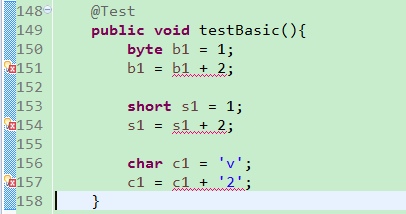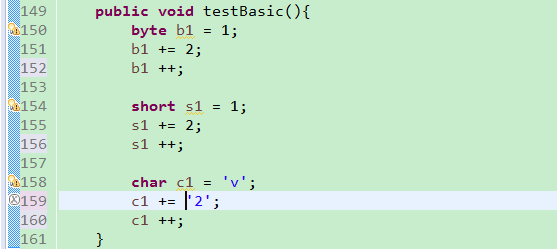说起源码其实第一个要看的应该是我们的父类Object,这里就不对它进行描述了大家各自对其进行阅读即可(其中留意wait()方法可能会存在虚假唤醒的情况)。
一、八种基本类型
接下来介绍我们的八种基本类型(这个大家都知道吧):char、byte、short、int、long、float、double、boolean。这里也不太描述其过多的东西,只说些要特别注意的事项(如果我这存在遗落的,欢迎大家补充):
1、byte、short、char 不能进行含有变量的运算符运算(正常的运算符),都要求进行强转,因为都有范围限制。

但是可以进行+= 和自增增减的操作。

2、自动转型等级:byte,short,char(同级)-> int -> long -> float -> double (由低精度到高精度),同级不能自动转型,需要强制转换
二、八种封装类型
先说共同点:
- equals方法:
只有同一类型的才能作比较,然后再比较其值。源码以short为例,其它几个都一样。
public boolean equals(Object obj) { if (obj instanceof Short) { return value == ((Short)obj).shortValue(); } return false; }
所以不同类型的不管值是否相等都是false;
@Test public void testEquals(){ Short num1 = 1; Integer num2 = 1; Long num3 = 1L; System.out.println(num1.equals(num2));//false System.out.println(num2.equals(num3));//false }
- 直接赋值时,都会调用valueOf方法。所以要注意其的源代码。
不同点:
1、Character
- 注意valueOf中代码,它缓存了ASCII码0~127的字符。其他均会创建实例。

2、Byte
- 范围是-128~127,所以超过这个范围会要求强制转换。如果使用Byte(String s)创建实例的话,超过范围会抛出异常:NumberFormatException
- 注意valueOf中的代码,它缓存了-128~127,所以直接赋值是不创建新实例的。

@Test public void testByte(){ //byte的范围是-128~127,针对byte如果赋值不在范围eclipse会要求强制转型成byte. //封装类型Byte new Byte("128")当使用字符串创建实例时,其中值超过范围会报错NumberFormatException。 byte b1 = 12; Byte b2 = 12;//(byte)129;//超过范围要求强转 Byte b3 = 12;//(byte)129; //Byte b4 = new Byte("128");//抛出异常 Byte b4 = new Byte("12");//抛出异常 System.out.println(b1 == b2);//true System.out.println(b2 == b3);//true System.out.println(b2 == b4);//false }
3、Short
- 跟byte的第一点一样,只是范围(-32768 ~ 32767)不一样
- 注意valueOf方法,它缓存了-128~127的值,超过这个范围(-128~127)就会创建新的实例。

- 基于第二种情况,不便于进行循环遍历复制操作,否则超过范围就会多个实例,影响内存。
@Test public void testShort(){ //1、short范围:-32768 ~ 32767 Short s = new Short("32767");//超过范围会报错 NumberFormatException s = new Short((short)327671);//超过这个范围自动转换 //2、装箱与拆箱 自动转型 short s1 = 12; Short s2 = new Short(s1);//手动装箱 System.out.println("s1 == s2:" + (s1 == s2));//自动拆箱 true //3、valueOf方法缓存了-128~127的范围,超过这个范围就要另外创建这个实例。 Short s3 = 12; Short s4 = 12; Short s5 = 128; Short s6 = 128; System.out.println("s3 == s4:" + (s3 == s4)); //true System.out.println("s5 == s6:" + (s5 == s6)); //false //4、由于上面这个特性,所以这种包装类型不能在循环遍历中赋值。不然其值超过这个范围的话,就会创建新的对象,如果很多的话,就会创建很多对象。浪费空间。 }
4、Integer
- 承受的值要注意范围(-2147483648 ~ 2147483647 ),不要求强转。
- 注意valueOf方法,跟Short的方法一样,缓存了-128~127的值,超过这个范围(-128~127)就会创建新的实例。

- 基于第二种情况,不便于进行循环遍历复制操作,否则超过范围就会多个实例,影响内存。
@Test public void testInteger(){ //1、Integer范围:-2147483648 ~ 2147483647 //后面与Short一样 //2、装箱与拆箱 自动转型 int s1 = 12; Integer s2 = new Integer(s1);//手动装箱 System.out.println("s1 == s2:" + (s1 == s2));//自动拆箱 true //3、valueOf方法缓存了-128~127的范围,超过这个范围就要另外创建这个实例。 Integer s3 = 12; Integer s4 = 12; Integer s5 = 128; Integer s6 = 128; System.out.println("s3 == s4:" + (s3 == s4));//true System.out.println("s5 == s6:" + (s5 == s6));//false //4、由于上面这个特性,所以这种包装类型不能在循环遍历中赋值。不然其值超过这个范围的话,就会创建新的对象,如果很多的话,就会创建很多对象。浪费空间。 }
5、Long
- 承受的值要注意范围(-9223372036854775808 ~ 9223372036854775807 ),不要求强转。
- 注意valueOf方法,跟Short的方法一样,缓存了-128~127的值,超过这个范围(-128~127)就会创建新的实例。

- 基于第二种情况,不便于进行循环遍历复制操作,否则超过范围就会多个实例,影响内存。
@Test public void testLong(){ //范围就不考虑了。 //同样、valueOf方法缓存了-128~127的范围,超过这个范围就要另外创建这个实例。 Long s3 = 12L; Long s4 = 12L; Long s5 = 128L; Long s6 = 128L; System.out.println("s3 == s4:" + (s3 == s4));//true System.out.println("s5 == s6:" + (s5 == s6));//false //由于上面这个特性,所以这种包装类型不能在循环遍历中赋值。不然其值超过这个范围的话,就会创建新的对象,如果很多的话,就会创建很多对象。浪费空间。 }
6、Float
- 承受的值要注意范围(-1.4E-45~ 3.4028235E38),不要求强转。
- 注意valueOf方法,跟前面的Short、Integer、Long不一样了,直接创建实例。

- 所以相等值的两个变量 ==运算是false.
- 不要做加减法运算。精度(9位)问题。
@Test public void testFloat(){ //没有特殊要注意的,其他跟上面一样 int f = 1; Float f1 = 1F; Float f2 = new Float(f); System.out.println(f == f1);//true System.out.println(f1 == f2);//false //注意不要用这类型做加减运算,精度问题会影响。 System.out.println(f1 - 0.1f*9);//0.099999964 }
7、Double
- 承受的值要注意范围,不要求强转。
- 注意valueOf方法,与float一样,直接创建实例。

所以相等值的两个变量 ==运算是false.
- 不要做加减法运算。精度(17位)问题。
@Test public void testDouble(){ //注意不要用这类型做加减运算,精度问题会影响。 System.out. println(1.0 - 0.1*9);//0.09999999999999998 //valueof Double i1 = 100.0; Double i2 = 100.0; Double i3 = 200.0; Double i4 = 200.0; System.out.println(i1==i2);//false System.out.println(i3==i4);//false }
8、Boolean
- valueof方法

缓存了两个方法,所以如果是同样的赋值,== 运算是为true的。
@Test public void testEquals(){ Short num1 = 1; Integer num2 = 1; Long num3 = 1L; System.out.println(num1.equals(num2));//false System.out.println(num2.equals(num3));//false }
三、案例分析
猜猜下面各个输出的结果是什么:
@Test public void test1(){ Integer a = 1; Integer b = 2; Integer c = 3; Integer d = 3; Integer e = 321; Integer f = 321; Long g = 3L; Long h = 2L; System.out.println(c==d); System.out.println(e==f); System.out.println(c==(a+b)); System.out.println(c.equals(a+b)); System.out.println(g==(a+b)); System.out.println(g.equals(a+b)); System.out.println(g.equals(a+h)); }
其中会涉及到拆箱与装箱(自行弄懂)的问题。针对个别解析如下:
c==(a+b) :a+b都会拆箱成int然后相加,所以c也会自动拆箱比较。
g==(a+b):同理,a+b都会拆箱成int然后相加,g会拆箱成long类型。所以基本类型比较只要比较其值即可。
g.equals(a+b):先拆箱a+b再装箱还是Integer,这里不会自动转型。Long类型的equals判断不是同一类型直接返回false
g.equals(a+h):同上,先拆箱a+h再装箱(这里会自动向上转型)为Long,所以同类型的比较值又相等,这里返回true.
最终结果如下:
true false true true true false true